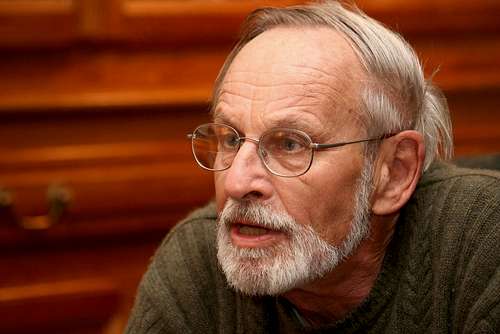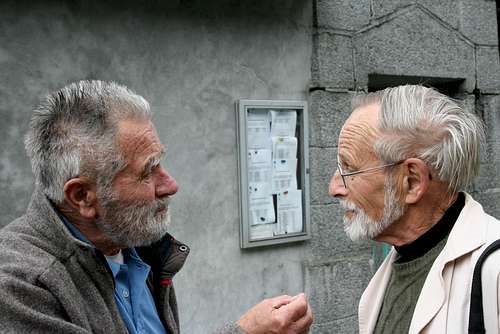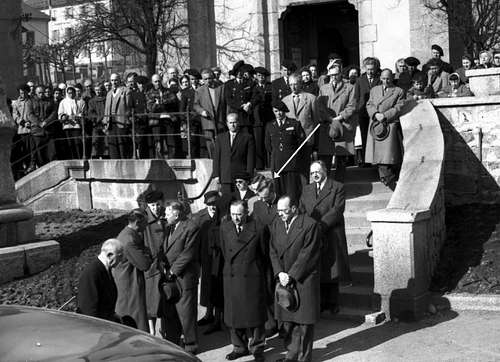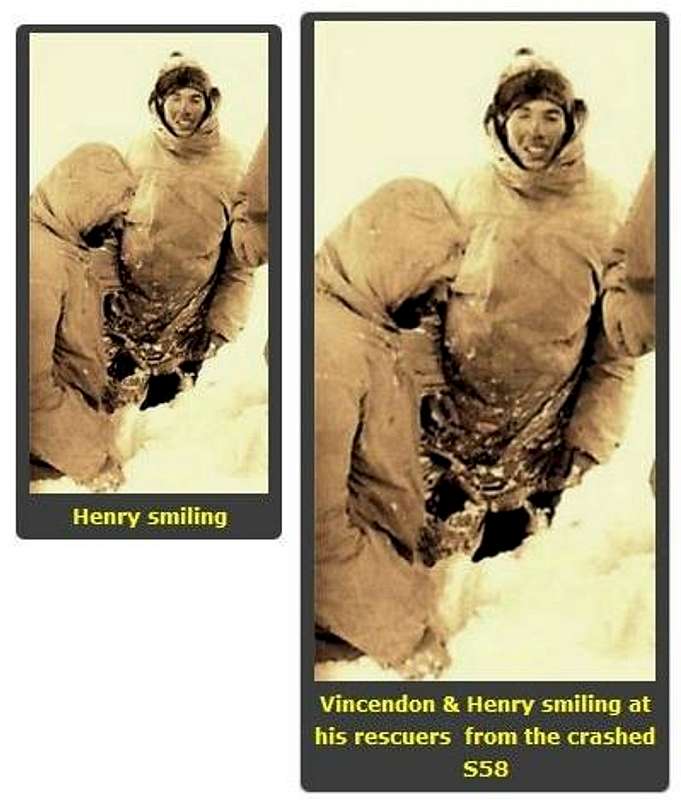After Claude Dufourmantelle, Jean Henry talks about the Vincendon-Henry affair "Naufrage au Mont Blanc".
Francois older brother lives in the United States since the time of the drama. Twenty years ago, when I was writing “Naufrage au Mont Blanc”, his testimony was very useful as he was very close to his brother with whom he had made some climbs in the Alps and they had kept a fascinating correspondence. Among others, he provided me with essential information and documents. In June 2007, on the occasion of a trip to France, he spent a few days at our house, and we went to Chamonix. This gave him the opportunity to meet Jean Minster and Gilbert Chappaz, the last two mountain guides rescuers still alive. A moving encounter during which Chappaz asked to be forgiven for not having delivered on his promise to come back to get the two “shipwrecked” settled in the broken shell of the helicopter. There was no need for forgiveness, told Jean Henry : “They could not go back to get them for a number of reasons, among which the bad weather. He lived with that his entire life, and it must have been terribly painful.”
Jean Henry read the various versions of the article of Eric Vola published on the summitpost.org site. And he decided to respond. It seems to me that this text, that he authorized me to publish, provides an answer to the “Bonatti controversy” initiated by Vola and, particularly to the question: “Did Bonatti abandon Vincendon and Henry?” If anyone could blame the Italian guide to have any responsibility in the tragic death of the two “shipwrecked” and hold it against him, it would be a close relative to the victims. In the case of Jean Vincendon, I can testify that neither his mother, nor his friends, in particular Bob Xueref, have ever held Bonatti accountable. In the case of Francois Henry, I let his brother Jean speak.
Yves BalluEric Vola’s article recently published on summitpost.org describes what is generally called the “Vincendon and Henry Affair” (“l’Affaire Vincendon et Henry”). Under the title “Shipwrecked on Mont Blanc: the Vincendon and Henry Tragedy” (referred to as “Shipwreck” in the following), Vola provides a condensed version of the book “Naufrage au Mont Blanc – L’Affaire Vincendon et Henry” (referred to as “Naufrage” in the following) of Yves Ballu published by Glénat twenty years ago and recently reedited by Guérin with illustrations and other additions. The base of Vola’s article is Ballu’s book, to which, of course, he added his own contributions. At times, reading “Shipwrecked” did surprised me. My intent here is not to initiate a new polemic, enough of them have been generated by the ”Affaire”, but to comment on some aspects of Vola’s article.
Reading the original version of Vola’s article, the photo with the caption “Henry smiling” did shock me. After several bivouacs laying on the snow, their limbs deeply frozen, the two alpinists see the rescue helicopter crash a few meters away and… they smile? Incidentally, the alpinist facing the camera is Vincendon whose smile appears more like a rictus while my brother is on the left of the photo in profile. I am relieved that Vola eliminated this tasteless caption from ulterior versions of his article but also disappointed that he did not bother to identify the two young men correctly.
Shortly after the tragic events, (February – March 1957), Bonatti and Gheser, independently, published articles describing the climb with the Vincendon-Henry rope. The two articles are essentially identical, report the same facts. Copies of these documents as well as others collected and used by Ballu while preparing “Naufrage” are available on Yves Ballu’s blog (yvesballublog.canalblog.com). Later on, and particularly when Ballu was preparing the first edition of “Naufrage”, he noticed differences between the original articles of Bonatti and his subsequent articles and books. On the other hand, forty years later, Gheser did not change his recollection of the events. In his introduction, Ballu warns readers that “when the recollection of a witness changes, the first version of the events will be considered as the most authentic”, thus the adoption of the original versions of Gheser and Bonatti. Given the similarity of these versions it is the logical choice. The common version of the climb is, in fact, very simple: after a very hard bivouac, Bonatti reaches the Franco-Belgian rope and leads the alpinists about one hundred meters higher where Gheser is waiting. They form a foursome rope that Bonatti leads to the top of the Brenva Spur under difficult conditions, the common rope explores the feasibility to go down directly to Chamonix through the “passage Balmat” (“Balmat’s way” or “ancient way”) which turns out to be too risky and, by common agreement, they separate into two individual ropes and plan to rejoin at the Vallot refuge. This is what “Naufrage” relates.
In the chapter “The Bonatti controversy” of “Shipwreck”, Vola discusses some aspects of the differences between the original articles of Bonatti and his subsequent publications.
An example of these differences is the case of Bonatti’s ice-ax broken during a recon towards “la Poire”. In his later articles, Bonatti states that the ice-ax was not broken but only cracked or split and that he fixed it with thin string. A question of semantics which certainly does not qualify as a “controversy” or a reason to criticize “Naufrage”. If the ice-ax had been declared “damaged” no question would have been raised. Further, nothing indicates that the ice-ax in question did not provide the services it was supposed to provide or that it would have handicapped the progression of the ropes. After mention of the repair, the ice-ax does not appear anymore in “Naufrage”. As far as I am concerned, there is no controversy here.
Another controversy brought up by Vola is that the two ropes would have regained their independence, i.e. would have separated, when the young alpinists, having a difficult time maintaining the pace of Bonatti, did propose to take a break to rest and eat close to the summit of Mont Blanc, which could suggest that Bonatti had abandoned them. “Naufrage” locates precisely the separation to have taken place 350 meters from the summit. But then, why would a separation at a higher altitude be considered as an abandonment while a separation at a lower altitude would be a separation and not an abandonment? This does not seem clear to me, but in the mind of Bonatti and Vola the controversy about a possible abandonment seems to depend on the location of the separation. In fact, Bonatti faced a terrible choice: a separation of the two ropes after the attempt to go down the “Balmat way”, about 350 meters below the summit, to let the two ropes progress at their own pace, the second rope benefitting from the tracks of the leading rope, or progress as a common rope until they were closer, say about fifty meters below the summit, then separate to let each rope reach the Vallot refuge over fairly smooth terrain. Bonatti choose the first option. Initially things went as planned: although being slower, the Franco-Belgian rope kept progressing and responded calmly to Bonatti’s verbal encouragements. So, Bonatti kept on as his rope mate Gheser started having difficulties walking and he wanted to reach the Vallot refuge before dark. Little did he know that the second rope was close to collapsing and had to stop and bivouac; he would have had little and probably no chance to find them in the dark. The second option, bringing everybody closer to Vallot before separating would have made it easier for Bonatti to go back and, may be, bring them to Vallot. However, given the slow pace of the common rope and the degree of exhaustion of the young climbers, it is very doubtful that they could have reached Vallot before dark which would have entailed another terrible bivouac for all four alpinists. I believe that Bonatti made the right choice, but in no case the other choice, that of a separation at higher altitude could not be considered as abandonment. One could even think the opposite. Personally, I have no doubts: Bonatti did not abandon Vincendon and my brother. Members of my family, friends and acquaintances with whom I spoke before and after the publication of “Naufrage” have never mentioned an abandonment. An abandonment or suspicion there of is not mentioned anywhere in “Naufrage”.
In his two original articles (February and March 1957), Bonatti states that after having abandoned the idea of going directly to Chamonix through the ancient passage (passage Balmat), he explained to the other members of the rope that the only viable solution was to reach the Vallot refuge, and that they all agreed to separate themselves in two ropes, so that the Franco-Belgian rope, being slower, could benefit from the track made by Bonatti. In his original article (February 1957) and his letter to Ballu (1997) Gheser confirms this. The testimony of warrant officer Blanc who reports the description of the events by my brother confirms this sequence of events. On the basis of these concurring testimonies confirming a separation at relatively low altitude, the idea of an abandonmentis rejected. Basing himself on the fact that the toponymy of Gheser is erroneous, Vola suggests that Gheser’s description of the events could lead to the assumption that the separation took place at a higher altitude and that Bonatti would have abandoned the Franco-Belgian rope. In his reports of the events, Ghezer calls the “ancient way” (or “passage Balmat”) the “Corridor”, which is erroneous. As can be seen from the illustrations in “Shipwreck”, the “Corridor” is parallel to the ancient way but at lower altitude, which reinforces the idea that the separation was not an abandonment. In his article in “Sport et Vie” (February 1957), Bonatti says: “First I had the intention of taking the “Corridor” … “. He refers here to his attempt to go down directly to Chamonix using the “passage Balmat” (“ancient way”). In Rivista, March 1957, Bonatti says: “… we are exactly on the col above the “Mur de la Cote” between the two Red Rocks …” and also “… the ‘”couloir” between the two Red Rocks (itinerary 176 of the Vallot Guide – parallel to the “Corridor” per se) …” and in a letter to Ballu “… realizing that the “Grand Couloir of the lower “oldway” was highly dangerous …”. It seems that Bonatti’s toponymy is quite variable but not considered erroneous. Gheser, certainly less familiar with the French side of Mont Blanc most probably simply adopted the terminology of Bonatti. Further, Gheser mentions the “Brenva col”, which is erroneous, but the combination of the col and the “Corridor” in its proximity corresponds exactly to the description of their location as given by Bonatti. A few lines after his criticism of Gheser’s toponymy, Vola adds “… a careful reading of the Gheser’s text confirms that the separation took place at the location mentioned by Bonatti”. In a short section of his article, Vola accepts the location of the separation mentioned by Gheser, then raises some doubts about it and then accepts it again. All this is confusing, not convincing at all and, in fact, pointless as the original reports of Bonatti and Gheser establish the location of the separation, and, mostly its reason (slow pace of the Vincendon-Henry rope and suggestion of a break to recover). Further, “Shipwreck” has been revised five times to my knowledge (I may have missed some revisions) since its original publication (June 2017). Most of the revisions are rewrites of “The Bonatti Controversy” chapter attempting to explain, justify or legitimize Bonatti’s changing recollection of the events which gives the impression of a text in preparation modified as the author gathers new data or is advised about errors.
In the same chapter of “Shipwreck”, Vola blames Ballu for having “made the dead talk”. In reality, Ballu does not make the dead talk, he assigns their own words to protagonists of the events in the form of conversations, discussions or declarations. These, in turn were obtained from testimonies that Ballu collected and from a variety of documents of the time that he gathered during his research (I have provided a number of such documents myself). This approach, often used in publications about historical events, makes the text more vivid and more attractive, as Vola recognizes. But, as Vola and some of his friends say, it turns “Naufrage” into a novel. According to the Oxford dictionary a novel is a “relatively long fictional prose narrative with a more or less complex plot or pattern of events, about human beings … “. “Naufrage” is definitely not a fictional narrative. Obviously everyone is entitled to his opinions, but I have a difficult time understanding how the description of the long agony of two young men, of the suffering and frostbites of a pilot who will remain handicapped for the rest of his life, of the efforts and risks the rescue team went through, some members of which will be haunted for years by their memories, all carefully documented in “Naufrage”, could compare to the description of an inquiry by Inspecteur Maigret or of an adventure of James Bond. Moreover, to appreciate what the expression “make the dead men talk” (“faire parler les morts”) alludes to, one should read “Naufrage” in French, which most readers of “Shipwreck” have not done. Why then insert this reference to the format of a text in French in an article in English and in a chapter dealing with the Bonatti controversy? “Naufrage” gives a chronological, carefully documented description of the events, which, together, add up to an important stage in the history of alpinism in the French Alps and of Chamonix in particular. Personally, I consider “Naufrage” as a historical document, but, as always, to each his own.
My comments regarding the Bonatti Controversy may appear as an “Anti-Controversy” or as the initiation of a new debate, which is not the case. I have tried to show that new interpretations based on rather secondary aspects of the events (Gheser’s toponymy, exact location of the separation, allusion to an abandonment, damaged ice-ax, rest and snack stop, …) are rather inconsistent and do not improve our understanding of the events. It is time to resign ourselves to admit that the facts as we know them now are the only ones we will ever know and that certain questions that we may ask ourselves will never be answered. It should also be noted that Vola’s original article did not include “The Bonatti Controversy” chapter; for the sake of his readers Vola should have kept it that way. There was never an “abandonment controversy” (not even in the Italian media!). This so-called controversy was, in fact and unfortunately, initiated by Bonatti’s changing testimony.
In the years following the tragedy, Bonatti modified his original description of the events. He blames Gheser whom he refutes systematically and Ballu for not having adopted his modified version of the facts. The tone of Bonatti’s criticism toward Gheser and Ballu suggests a vindictive, verbally aggressive and, at times, nasty person. I have never met Bonatti, but basing myself on some of his publications I read, his photo reports, comments and hear say, I imagined a supremely gifted alpinist, proud of his achievements, self-confident, and affable. This last trait is well illustrated by the friendly relationship that developed between the two ropes at the Fourche refuge the evening before the climb. Why did Bonatti react in such a virulentway? How to explain this change in personality? We will never know for sure, but I would like to propose a possible explanation which could reconcile these opposed aspects of his personality. After he extracted the Franco-Belgian rope from its bivouac and joined it to his own rope, undoubtedly saving the lives of the two young men, he assumed full responsibility of the three alpinists. In a letter to Ballu, Bonatti explains : “In addition, I would add that all, tacitly (and since the first morning in the storm as members of the same rope), trusted me and considered me as the strongest and most experienced one”. This seems obvious to me. When he proposes to separate into two ropes to progress faster and to regroup at the Vallot refuge, everybody agrees because they all trust him. This trust places a serious responsibility on his shoulders which, perhaps, will weigh heavily on him later. Upon reaching the refuge, as a responsible leader would, he first cared for Gheser’s frostbites which looked quite serious, then considers going out in the dark of the night to look for “his” second rope. Gheser dissuades him to do so. Bonatti did not know that the second rope was exhausted and had resigned themselves to a second bivouac and that he would never see them again. For Bonatti who had assumed the responsibility of the two ropes, this was a failure. As a conscientious guide, he probably searched his memory to restore the sequence of events to determine how he could have avoided that failure. This call to his memory is probably what led him to modify his original reports of the events. In an essay “An Afterword…” recently added to “Shipwreck” and also posted in French and in English on Yves Ballu’s blog (these versions include an introduction by the author missing in “Shipwrech”’s version), Claude Duformantelle discusses the role of one’s memory as one tries to reconstruct situations in which one participated. He says, among others, “ This means that a memory, a recollection, a reminiscence, is constantly reconstructed by one’s poor mind inits futile attempts to figure out what one has really done, what really happened and to imagine what could have happened if … or what one should have done if… if what? To change the past? To explain the past? To understand the past or simply to exempt oneself from the past.” Given the criticism that had been heaped on him (notably after the Italian expedition to K2), it is quite possible that Bonatti’s memory led him towards a version of the events that should have avoided new criticism, even if that meant changing his testimony if necessary. All this is only a hypothesis which we will never be able to confirm and it does not change in any way my admiration, respect and gratitude towards Bonatti.
In the apologue to the recent version of “Naufrage”, I had suggested that the book should be compulsory reading for candidates to mountaineering professions. Recently, I was glad to learn that the book is included in the library of the “Peloton de Gendarmerie de Secours en Haute Montagne” (the elite rescue group operating in the French Alps) and is being read: even after sixty years, the human interactions described in “Naufrage” remain actual.




